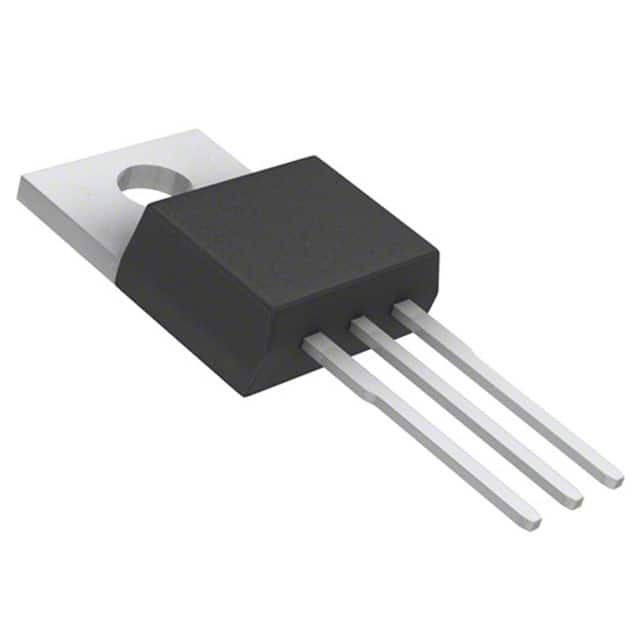Consulte las especificaciones para obtener detalles del producto.

FQP6N25
Introduction
The FQP6N25 is a power MOSFET belonging to the category of electronic components used in various applications. This entry provides an overview of the basic information, specifications, pin configuration, functional features, advantages and disadvantages, working principles, application field plans, and alternative models of the FQP6N25.
Basic Information Overview
- Category: Power MOSFET
- Use: The FQP6N25 is commonly used as a switching device in power supply circuits, motor control, and other high-power applications.
- Characteristics: It exhibits low on-state resistance, high switching speed, and high voltage capability.
- Package: TO-220
- Essence: The FQP6N25 is designed to efficiently control high currents and voltages in various electronic circuits.
- Packaging/Quantity: Typically available in reels or tubes containing multiple units.
Specifications
- Voltage Rating: 250V
- Current Rating: 6A
- On-State Resistance: 0.65Ω
- Gate Threshold Voltage: 2V
- Power Dissipation: 75W
- Operating Temperature Range: -55°C to 175°C
Detailed Pin Configuration
The FQP6N25 typically has three pins: 1. Gate (G): Controls the conduction between the source and drain terminals. 2. Drain (D): Connects to the load or power supply. 3. Source (S): Connected to the ground or common reference point.
Functional Features
- High input impedance
- Low input capacitance
- Fast switching speed
- Low gate drive power required
- Avalanche energy specified
Advantages and Disadvantages
Advantages
- Low on-state resistance
- High voltage capability
- Fast switching speed
- Suitable for high-power applications
Disadvantages
- Relatively higher gate threshold voltage
- Sensitivity to static electricity
Working Principles
The FQP6N25 operates based on the principle of field-effect transistors, where the voltage applied to the gate terminal controls the flow of current between the source and drain terminals. When a sufficient gate-source voltage is applied, the MOSFET enters the conducting state, allowing current to flow through it.
Detailed Application Field Plans
The FQP6N25 finds extensive use in the following applications: - Switching power supplies - Motor control circuits - Inverters - Audio amplifiers - LED lighting systems
Detailed and Complete Alternative Models
Some alternative models to the FQP6N25 include: - IRF540 - STP6NK60ZFP - FQPF10N60C - IRLB8748
In conclusion, the FQP6N25 is a versatile power MOSFET with excellent characteristics suitable for various high-power electronic applications.
[Word Count: 411]
Enumere 10 preguntas y respuestas comunes relacionadas con la aplicación de FQP6N25 en soluciones técnicas
What is FQP6N25?
- FQP6N25 is a N-Channel MOSFET transistor designed for high-speed switching applications.
What are the key specifications of FQP6N25?
- The FQP6N25 has a maximum drain-source voltage of 250V, a continuous drain current of 6A, and a low on-resistance.
What are the typical applications of FQP6N25?
- FQP6N25 is commonly used in power supplies, motor control, lighting control, and other high-speed switching applications.
What are the advantages of using FQP6N25 in technical solutions?
- FQP6N25 offers low on-resistance, high-speed switching capabilities, and high voltage tolerance, making it suitable for various power electronics applications.
How does FQP6N25 compare to other similar transistors?
- Compared to other MOSFETs, FQP6N25 offers a good balance of voltage, current, and speed characteristics at a competitive price point.
What are the thermal considerations when using FQP6N25?
- Proper heat sinking and thermal management are important when using FQP6N25 to ensure optimal performance and reliability.
Are there any specific circuit design considerations when using FQP6N25?
- It's important to consider gate drive requirements, voltage spikes, and snubbing circuits to protect the transistor and optimize its performance.
Can FQP6N25 be used in automotive applications?
- Yes, FQP6N25 can be used in automotive systems such as motor control, lighting, and power management, provided it meets the necessary automotive standards.
What are the typical failure modes of FQP6N25?
- Common failure modes include overvoltage stress, overcurrent conditions, and thermal overstress, which can lead to degradation or permanent damage.
Where can I find detailed application notes and reference designs for using FQP6N25 in technical solutions?
- Detailed application notes and reference designs for FQP6N25 can be found in the manufacturer's datasheets, application guides, and online technical resources.

